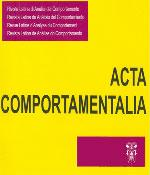O uso de dicas para o ensino de leitura e matemática
Contenido principal del artículo
Resumen
Reading and math skills are often required on a day-to-day basis. However, the performance of Brazilian students is much lower than expected in both skills. Studies in the area of Behavior Analysis have shown useful procedures for teaching reading and mathematical skills. The aim of this article was to verify the effect of the use of prompts on the repertoire of reading and mathematics of an 8 years old student with typical development who presented low school performance. Thirty sessions were conducted, each lasting 50 minutes. The reading and math training occurred alternately. In both reading and mathematics we performed a Pretest, Training 1, Post-test 1, Training 2 and Post-test 2. The tasks were displayed in the exercise book with cursive letters with no options of choice and the tasks were planned according to the results of the Pre-test. Aiming at learning with minimal errors, prompts were available in the training and they could be vocal, visual or gestural, and they were faded throughout the study. In the reading tasks were trained words with simple syllables, words with difficulties of the Portuguese language and phrases. For the training were used: pairing of the letter, phoneme and figure, oralization and copying of syllables, words and phrases, and dictation. In the mathematics tasks were trained operations with: numerical discriminations, single digit addition, two digit addition, single digit subtraction, two digit subtraction, addition with regrouping, subtraction with regrouping and single digit multiplication. The following training strategies were used: sentences oralization, the use of the fingers to operate with numbers and the result writing in the exercise book. Correct answers in training were followed with praise and a “right” sign in the exercise book. The results showed repertoire acquisition in all trained skills. In the reading tasks the participant obtained high performance in the reading of the training words and phrases and in the reading of the generalized and recombined words and phrases. The reading comprehension was verified. In mathematics, the child began to discriminate the numerals and she accomplished operations in the training and operations of the generalization in the tests. In this study, vocal, visual and gestural prompts worked as supplementary stimuli that ensured correct response from the first attempts, which allowed learning with minimal errors. The prompt fading strategy facilitated the transfer of stimuli control from the prompt to the task stimuli and prevented a possible dependence on prompt. In sum, the study results suggest that the presentation of tasks in the exercise book with cursive handwriting combined with Behavior Analysis procedures, such as the use of fading prompt strategy, is effective in teaching reading and mathematics for children with low school performance. It have been suggested that more research be carried out with the purpose of investigating the relevant variables in the control of students’ school performance, especially regarding the use of prompts such as: modality, duration, fading out strategies, among others.
Detalles del artículo
Cómo citar
Queiroz Amaral, A. R., Menezes Duarte, Ângela M., & Maria Melo, R. (2019). O uso de dicas para o ensino de leitura e matemática. Acta Comportamentalia: Revista Latina De Análisis Del Comportamiento, 27(3). Recuperado a partir de https://revistas.unam.mx/index.php/acom/article/view/70626
Citas en Dimensions Service

<a rel="license" href="http://creativecommons.org/licenses/by-nc-sa/4.0/"><img alt="Licencia de Creative Commons" style="border-width:0" src="https://i.creativecommons.org/l/by-nc-sa/4.0/88x31.png" /></a><br />Este obra está bajo una <a rel="license" href="http://creativecommons.org/licenses/by-nc-sa/4.0/">licencia de Creative Commons Reconocimiento-NoComercial-CompartirIgual 4.0 Internacional</a>.
